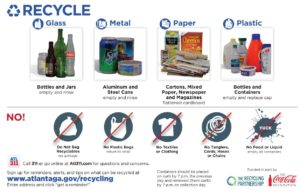A lot of us may have seen the VSCO girl memes, telling us to “save the turtles” with their Hydroflasks and metal straws. I find it fascinating that metal straws have become a trend, restaurants have stopped providing plastic straws, and plastic bag bans are being implemented across the country. These sustainability trends sound great, but are they actually helping the environment and making a positive impact? It has been estimated that 8.3 billion plastic straws line the world’s coastlines, but they only make up 4% of total plastic waste, and according to The Atlantic, reusable tote bags use more energy to manufacture than a typical plastic grocery bag, and people tend to accumulate these tote bags, defeating the purpose of reusing them.
Sustainability is a big buzz word in the field of materials science. I talked to Nasreen Khan, a PhD candidate in Materials Science and Engineering at the Georgia Institute of Technology, to find out more about sustainable materials. Nasreen and other graduate students in her lab have recently created a podcast called “Talk Green to Me,” with episodes covering different classes of materials and their impact on the environment.
The first thing I wanted to know was the definition of sustainability. Nasreen describes it as “taking positive action toward the protection and betterment of the environment.” So how are materials a part of the conversation around saving the environment? I asked for Nasreen’s opinion on what materials most affect our environment today. She replied with “microplastics, simply because of the sheer quantity of them that are in our environment, and we don’t quite know how they affect organisms.” Microplastics come from plastic waste naturally breaking down into smaller particles, as well as microbeads present in many consumer products, such as cosmetics. These microplastics pollute water systems, which are ingested by marine life and cause internal damage, and are even present in drinking water, though the extent of these effects are still being researched.
How do plastics degrade and why do they degrade slower than other materials? Metals and ceramics break down through corrosion, and they eventually become part of the environment. Corrosion of these materials typically happen through interactions with water that strips away ions. Plastics have varying degradation times depending on the polymer, but are typically much longer than metals or ceramics due to functional groups that aren’t easily cleaved by water. These stronger covalent bonds cause plastics to stay in the environment for many years before breaking down.
I asked Nasreen’s opinion about the effectiveness of reusable bags and straws. She argues that these trends are impactful because they have created awareness of how people’s choices affect the environment. This motivates people to think more about their consumption habits.
So what else can we be doing? As a recycling connoisseur, Nasreen has many resources to suggest. Some general things included consuming less, reusing and repurposing items, especially textile waste. Nasreen also suggests “[buying] from companies that use recycled content because that will expand the market for recycled products.” Target is an example of a company that is making large efforts to create sustainable products such as packaging, paper, and clothing.
In addition to choosing companies with sustainability efforts, municipalities typically provide information online that indicates how to recycle and what recycling efforts are happening. A recycling info card is available through atlantaga.gov to help people understand what can and cannot be recycled:
Other recycling resources in Atlanta include MandM Waste, which recycles scrap metal, UseAgain, which does textile recycling, and the Center for Hard to Recycle Materials (CHaRM). Outside of Atlanta, TerraCycle is an international waste recycling program that can recycle products from used makeup to brita filters. Links to all of these resources are at the end of the article.
Recycling correctly may take effort, but creating a regular habit can contribute to saving the environment. Looking back to the podcast created by Nasreen and her colleagues, I asked why they decided to create it in the first place. Nasreen said the goal was “to teach people about materials science and help them see the relevance and importance of sustainability.” Materials are such a big part of our daily lives, it’s crucial to be educated on how we are using and consuming them. If you want to learn more about the details of different classes of materials and their impact on the environment, check out “Talk Green to Me”, available on Spotify and iTunes.
City of Atlanta Recycling Information: https://www.atlantaga.gov/government/departments/public-works/recycling-program
MandM Waste: https://www.mandmwaste.com/scrap-metal-recycling-in-atlanta-ga-p-60.html
CHaRM: https://livethrive.org/charm/
TerraCycle: https://www.terracycle.com/en-US
Sources:
- Borenstein, Seth. “Science Says: Amount of straws, plastic pollution is huge,” Boston News. April 20, 2018. Available: https://www.boston.com/news/politics/2018/04/20/science-says-amount-of-straws-plastic-pollution-is-huge
- Dillon, Noah. “Are Tote Bags Really Good for the Environment?” The Atlantic. Sep 2, 2016. Available: https://www.theatlantic.com/technology/archive/2016/09/to-tote-or-note-to-tote/498557/
- Jordan, Rob. “Do plastic straws really make a difference?” Stanford Earth. Sep 18, 2018. Available: https://earth.stanford.edu/news/do-plastic-straws-really-make-difference#gs.67cow8
- Target’s Sustainability Policies and Partnerships: https://corporate.target.com/corporate-responsibility/planet/sustainable-products

